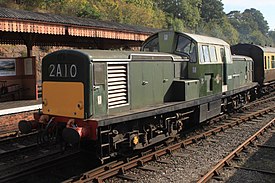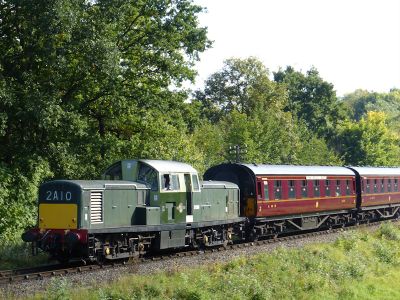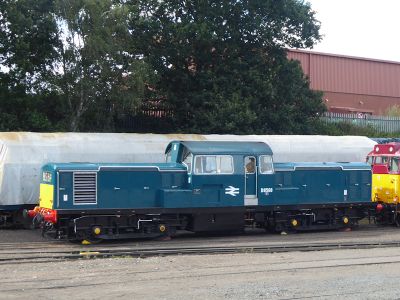Clayton Class 17 Bo-Bo D8568
| Clayton Class 17 Bo-Bo D8568 | |
|---|---|
 D8568 arriving at Bewdley from Kidderminster in 2015 | |
| Built By | Clayton Equipment Company Limited |
| Configuration | Bo-Bo |
| Power type | Diesel Electric |
| Status | Operational |
| Loco Number | D8568 |
| Other Numbers | 8568 |
| History | |
| Built | 1964 |
| Type | Class 17 |
| 1971 | Withdrawn |
| 1972 | Industrial service |
| 1983 | Preserved |
| 1989 | Returned to traffic |
| Technical | |
| Length | 50ft 7in |
| Weight | 69 tons |
Clayton Class 17 D8568 is the only surviving example of the Clayton Type 1s which numbered 117 in total.
Contents
D8568 in BR service
Intended by British Railways as the standard Type 1 for the railway system, supplanting the EE type 1 (later class 20), poor reliability meant withdrawals began as early as 1968, when some members were just four years old. Although the Class was allocated a TOPS code, none of the locomotives survived long enough for renumbering.
All but two of the class were fitted with pairs of the 450hp Paxman 6ZHXL 6-cylinder horizontal engines designed for (but never used in) in railcars. Three variations of the class were built:
- Class 17/1 (Clayton locomotives, with GEC generator)
- Class 17/2 (two locomotives), with Rolls Royce engines
- Class 17/3 (Beyer Peacock sub-contract built examples D8588-D8616, with Crompton Parkinson generator)
The Class was equipped for multiple working with 'Red Diamond' (Class 17/3: 'Blue Star') locomotives. Although D8568 is the unique survivor one of each sub-class 17/1 (8521) and 17/3 (8598) survived into BR Departmental service at Derby Research Centre until 1978.[1]
D8568 spent all of its working life in Scotland where it was delivered on 6 January 1964, to Haymarket, moving to Polmadie on 28 September 1968. It remained operating at this depot until it was withdrawn from service on 6 October 1971.[2]
D8568 in industrial service
Sold from Polmadie, D8568 went to Hemelite of Harpenden, a cement company on the former branch line between Harpenden and Hemel Hempstead. It arrived under its own power on 11 September 1972, to become the first 'privately owned' ex-main line diesel loco to break the 'no private diesels BR ban'.
D8568 was sold to Ribble Cement (now Castle Cement) and moved to Clitheroe, arriving on 24 June 1977. D8568 was repainted into the new owning company colours of light grey upper body with the running plate, bogies and underframe in dark green. The company logo of a castle was applied to the cab sides and nose ends.
D8568 in preservation
Purchased by the DTG it left Clitheroe on 9 February 1983 for the North Yorkshire Moors Railway, returning to traffic 22 April 1989. On 25 April 1992 it moved to a new home on the Chinnor and Princes Risborough Railway.
As it is owned by the Diesel Traction Group, which has other locomotives based on the SVR, it was a visitor for galas, first in 1998 and several times from 2015 with extended stays. During such visits it was sometimes referred to as a 'home fleet' locomotive in publicity. It was hired in between May and September 2017. D8568 also visited for repairs, and from 2020 to 2022 underwent a repaint into BR blue livery, bodywork attention and work on the Paxman engines,[3] before returning to Chinnor to complete its agreed running dates.
The loco is now based at the SVR[4].
See also
References
- ↑ Railuk.info (Retrieved 4 August 2019)
- ↑ BR database (Reterieved 4 August 2019)
- ↑ Branch Lines newsletter, September 2020 (Retrieved 29 August 2020)
- ↑ SVR Operations Manager, 15 March 2023
Links
| ||||||||||||||||||||||||||||||||||||||||||||||||||||||||||||||||||||||||

